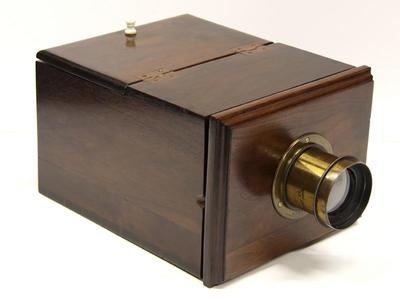Camera Obscura
Production date
2009
Description
A camera obscura with a European walnut and rimu body and a brass bound lens.
See full details
Object detail
Artist/Maker
Production role
Maker
Production date
2009
Production place
Classification
Credit line
In
October
1833,
William
Henry
Fox
Talbot
–
who
later
invented
the
negative/positive
photographic
process
–
was
using
a
camera
obscura
in
Italy
to
assist
with
his
drawing.
He
recalled
the
moment
some
years
later,
saying:
“And
this
led
me
to
reflect
on
the
inimitable
beauty
of
the
pictures
of
the
nature’s
painting
which
the
glass
lens
of
the
Camera
throws
upon
the
paper
in
its
focus
–
fairy
pictures,
creations
of
a
moment,
and
destined
as
rapidly
to
fade
away.
It
was
during
these
thoughts
that
the
idea
occurred
to
me
…
how
charming
it
would
be
if
it
were
possible
to
cause
these
natural
images
to
imprint
themselves
durably
and
remain
fixed
upon
the
paper!”
Though not the first to think of this idea, Talbot was the first to solve the technical problems that prevented it coming to fruition. In 1834, he discovered that paper soaked with a combination of common salt and silver nitrate became light sensitive enough to capture an image. These contact prints, or ‘photogenic drawings’ as Talbot called them, were crucial to the development of photography. This camera obscura is a replica of the portable versions used by artists to trace scenes accurately. The mirror inside the camera – used to turn the image the right side up – is front surfaced, achieved using deposited silver as would have been done in the 1800s. The lens is an original 19th Century brass bound lens with a focal length of approximately 300mm. A camera obscura is an optical device that contributed significantly to the invention of photography. It operates on the principle that light from an illuminated object passes through a hole into a darkened enclosure and strikes a surface, resulting in an upside down but otherwise exact image of the object. This principle was discovered as early as the 5th Century B.C. by Chinese scholar Mo Ti.
Though not the first to think of this idea, Talbot was the first to solve the technical problems that prevented it coming to fruition. In 1834, he discovered that paper soaked with a combination of common salt and silver nitrate became light sensitive enough to capture an image. These contact prints, or ‘photogenic drawings’ as Talbot called them, were crucial to the development of photography. This camera obscura is a replica of the portable versions used by artists to trace scenes accurately. The mirror inside the camera – used to turn the image the right side up – is front surfaced, achieved using deposited silver as would have been done in the 1800s. The lens is an original 19th Century brass bound lens with a focal length of approximately 300mm. A camera obscura is an optical device that contributed significantly to the invention of photography. It operates on the principle that light from an illuminated object passes through a hole into a darkened enclosure and strikes a surface, resulting in an upside down but otherwise exact image of the object. This principle was discovered as early as the 5th Century B.C. by Chinese scholar Mo Ti.
Accession number
PA2009.052
Collection type

Public comments
Be the first to comment on this object record.